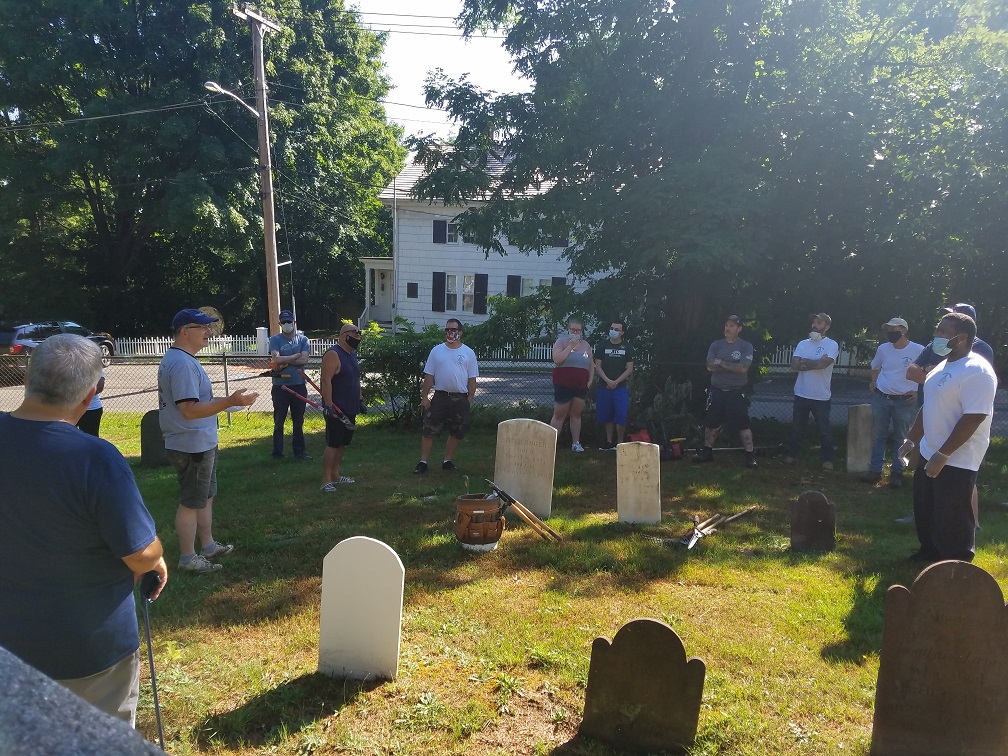Huntington’s Masonic Lodge Volunteers at Old Burying Ground
Walking through a field of stone carved skulls and faces, transports visitors to a rare and unique collection of early Huntington folk art. The cracks widen during the passage of time, slowly eroding the hand carved markings created by forgotten artisans in remembrance for our local ancestors. Many passerby’s in the Old Town Hall Historic District may not know that resting beneath the stone tablets are the remains of early Huntington residents from a wide variety of backgrounds.
On a recent hot and humid Saturday morning, fourteen members, friends, and family of Jephtha Masonic Lodge No. 494 volunteered to help trim shrubs, pull overgrown weeds, rake leaves, and remove debris from Old Burying Ground Cemetery. In coordination with Huntington Town Historian Robert Hughes, the work crew assisted in a day of cleanup at the historic cemetery just short walking distance from the Jephtha Lodge building on New York Avenue. Huntington Town Supervisor Chad Lupinacci took a short walk from the nearby Town Hall and spoke to the group about the importance of preserving our local historic sites and sharing his appreciation on all the hard work accomplished.

Part of the lodge’s benevolence committee to help make our community a better place, this event is one of several projects the local Masons were involved in during the recent pandemic shutdown. Although the lodge is comprised of mostly Huntington residents, members from other lodges from as far as Port Jefferson volunteered in this important preservation project of our local historic sites. Armed with work gloves, pruning shears, weed trimmers, a cooler of cold bottled water and a bit of determination, the team went right to work after a brief historical lecture by the Town Historian.
Also known as the Old Burial Hill Cemetery, the site has been listed on the National Register of Historic Places since 1981. The earliest surviving marker is over 300 years old, but many of the wooden markers and basic fieldstones were lost over the years and never replaced. Located on a hill that once had a clear view of Huntington Harbor, the site was originally chosen because of the difficulty to farm on the hilly terrain.
The cemetery took an ugly turn in 1782, the last year of the American Revolution, when occupying British troops, under the orders of Colonel Benjamin Thomson of the King’s American Dragoons, destroyed the nearby Presbyterian Church and constructed Fort Golgotha with timbers removed from the sacred building on the highest point of the hill. The fort was part a network of four British fortifications including Fort Slongo, now known as Fort Salonga, in the hamlet on the border of the Towns of Huntington and Smithtown, in British occupied Long Island during the Revolutionary War.
The British desecration of the church and cemetery is the first recorded act of vandalism in Huntington. Up to 100 tombstones were destroyed and some were used as bake ovens where according to local legend, the baked bread had reverse inscriptions of the tombstones readable on the lower crust.

There are 1246 marked graves on the 4-acre site, but it is estimated that there may have been up to 5000 interments since the founding of the Town of Huntington in the mid-17th century. The first legible marker is dated 1712 and the final burial of Russell F. Sammis was in May 1957. Town Historian Robert Hughes explained to the group the variety of tombstones that can be seen in the cemetery, including local fieldstones, imported Connecticut sandstone, slate and how marble, iron, zinc and granite replaced the older varieties in the 19th and 20th century. Many of the markers included unmarked footstones, which sometimes can be confused as headstones to the unsuspecting eye.
With the opening of Huntington Rural Cemetery as the Town’s main cemetery on New York Avenue in the mid-19th century, Old Burying Ground started its long decline of neglect until the local chapters of the Sons and Daughters of the American Revolution started their own cleanup efforts in 1911 giving way to the Town of Huntington’s regular maintenance in the mid-1920s. Suburban expansion in the 1950’s witnessed the return of vandalism to the cemetery, which finally led to a joint effort of between the Town of Huntington and the New York State Office of Parks, Recreation and Historic Preservation to the restoration, conservation and preservation of the grounds in a multi-year project that started in 2004.
This project between the Town Historian is the latest of several coordinated efforts with Jephtha Masonic Lodge which has called Huntington home since 1860. Other projects include the installation of an Historic Marker in front of the lodge building on New York Avenue; a stop on the Huntington Walking Tour and Pub Crawl; archive sharing between the lodge and the Huntington Historical Society; and invaluable assistance in the newly published book “Long Island Freemasons.”
The post Huntington’s Masonic Lodge Volunteers at Old Burying Ground appeared first on Jephtha.com.

